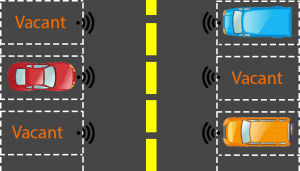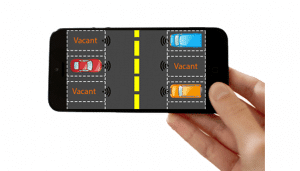Parking lots have largely been ignored when it comes to technological innovations and ideas. However with the number of cars on the street increasing, and along with it the time taken to park, the parking problem will now have to be addressed effectively. Devavrat Kulkarni, Senior Business Analyst at Maven Systems Pvt. Ltd shares his insight on Smart parking as part of Smart-City Initiative
What’s wrong with normal parking?
Simply put, normal parking is inefficient, frustrating and time-consuming. Driving around after arriving at a mall or a multiplex is annoying while searching for a parking spot in a hospital parking lot is nerve-wracking. The issue at hand is simple parking lots have been ignored while automobiles have been making huge strides. However, that is about to change. Frost & Sullivan report that the current global $100 billion industry is looking at investments to the tune of $200-$250 million till 2019. Navigant Research believes that by 2020 we could be looking at around a million smart parking spaces worldwide.
How to bring about the revolution?
So what makes off-street parking lots so difficult to work with? For starters they are huge, they are multi-layered, and frankly people have almost accepted trying to find a free space as a part and parcel of life. However there have been pilots and experimental setups and the results, while in their infancy, are promising.
One example is Baltimore / Washington Airport that has huge boards which guide towards free spaces. However they do not use occupancy sensors, so they cannot guide the driver right up to the parking space but rather to an approximate location. On the other hand a team from RICE University has developed a model where camera is used to click minute by minute photos of the parking lots. These photos are then analyzed by a computer, and using object detection algorithm the fee spaces are found and communicated to the user.
However there is still a lot of room for development and improvement in this segment.
A smart solution
A truly smart parking system should not only be aware of the occupancy status of each parking space, but also be able to guide the user to it. All of this should happen with no human intervention. A smart solution would have the following parts:
Occupancy sensors
As mentioned before each parking space should be taken into account by the system. Multiple types of sensors can be used for this work. However, the accuracy of the sensors cannot be compromised upon, a minimum number of false positives is a must. As the number of sensors increases their cost will reduce drastically. When the status of the sensors changes they will report it to a gateway device.
The issues to be tackled here are battery life, positioning of sensor and communication channel. As there will be a large number of sensors, wiring them for energy is out of the question. As a result these sensors have to be battery powered, and consequently must have power management algorithms. The enclosure of the sensors will have to take into account the positioning of the sensors. If installed in the open, the sensors need to be protected from heat, dust, rain, bugs and other natural phenomena, installed on the floor of the parking lot the sensors need to be able to take the weight of the car without malfunctioning or breaking down. In order to keep the number of gateway devices to a minimum, the servers must communicate on a technology that has a long reach like RF, or must work on a mesh protocol, so that the status change will reach the gateway by hopping.

Gateway devices
These gateway devices will be used to collect the status from the sensors and then send them to the server. The gateways will work on wireless technology to transmit the status. A single gateway device will be used to collect the readings of multiple sensors. A single gateway fetching the status of up to 500 sensors will be considered as a good solution.
The issues that will be faced for gateways will be range, power supply, and cost. Installing a large number of gateways on each parking floor will raise the cost of the solution. As a result, the gateways should be far and few, and should work on a medium that gives it maximum range like RF. Also a mesh network for gateways will ensure that multi-floored and non-straight parking lots will be covered. Unlike sensors which will be operational only when the status changes, gateways need to be up and running throughout the day. As a result they will need a continuous power supply. The cost of the gateways should be, as low as possible. For this it is important to increase the life by using the best possible hardware components, using voltage protectors and enclosures that will be able to stand extreme conditions like heat, cold, dust and bugs.
Server
The server device will collect the status from multiple gateways. It will then compute which parking spaces are free and which are occupied. When a new user enters the parking lot, the server will communicate with the user’s mobile application. The server will send the map of the parking area and the location of the free parking spot in order to guide the user. In this way the user will not have to drive around searching, but rather to a specified destination.
The issues that the server will face will include dual protocol compatibility. As the server will communicate with both the gateway and the mobile application, it will have to run on two distinct communication protocols GPRS, and RF. For on-street parking, the server will have to consider a map of the streets, the side of road to park (for countries with alternate parking rules), and the destination at which the user wants to park, so that the nearest free parking from the spot can be found. For off street parking, the server has to only consider a map of the entire parking structure. In both cases the server will communicate the location and the map, the path and directions will be shown by the mobile / tablet device that has the parking application.
User touch point
The user touch point is a smart phone application that can be run on either a smart phone or tablet. The application will receive the map of the parking and the location to park in from the server. After this is received, the application will direct the user to the parking location. For on-street parking the application will use GPS in order to get the directions. For off-street parking the application will have to use devices installed inside the parking lot to get reference regarding where the car is at the moment.
The use of the application is two-fold. Once the user has parked the car, the user will confirm the location and the application will store it. When the user is trying to find the car, the application will guide the user from the current location to the car. This will reduce the amount of time that users have to spend while trying to locate their car. Once again, in case of on-street parking the application will use GPS while for off-street parking the application will use the reference devices installed inside the parking space.
Future directions

As said earlier, the smart parking solutions are still in the infancy state. As these solutions mature, additional features will be offered that will make parking easier for customers.
- Payment modes: Both on-street and off-street parking spaces charge for parking. This entire transaction can be made from the mobile phone. Also specific parking lots have a time limit, usually on-street parking. In case a car over-stays the amount of time it is parked, an alert can be sent out to the towing company / police in order to take the car to the impound lot.
- Parking reservation: Instead of driving to the parking lot and then getting directions, customers will be able to reserve parking from their home, even before leaving. For this, the server will have to be connected to the Internet, and must recognize the appropriate customer.
- Connected lighting: Parking lots are kept illuminated throughout the day. As smart solutions will keep track of which parking spaces are occupied and which aren’t this will change. Sectors with no occupancies will be dimmed out. Similarly, office parking lots can be dimmed during work hours. As every new car entering will be detected, appropriate sectors can be illuminated, and others kept at diffused setting.
- On-street parking: On-street parking will be the next sector that will be targeted once off-street parking has reached a better state. Already pilot projects are being implemented in the cities of Los Angeles and San Francisco.
- GPS based directions: For both on-street and off-street directions, GPS based systems will no doubt be the best possible solution. The user will be able to get real time directions that will guide to the parking space. It won’t be just a route drawn on a map, but rather arrows pointing towards the possible destinations. However at the present moment getting GPS connection inside parking lots is difficult. It will take lots of innovation and technological wizardry to achieve.
- Better governance and traffic jam avoidance: The data of parking spaces, especially the day of the week and time of parking can be useful for both local governing bodies and for citizens. For local government bodies the patterns of high and low parking density will result in deciding tariff rates that will discourage customers from using cars on certain days. This will help reduce traffic congestions. Variable tariff rates will also encourage carpooling. For the citizens, the availability of data will help them plan better while going to a particular destination. They will be able to opt for public transport when parking spaces are less. The historic trends will work in the favor of citizen as well.
Let’s park hassle-free
Smart parking spaces have started to make an impression in the minds of entrepreneurs and business folks alike. The market is heavily under-serviced and innovations are rare. However, it is huge in size and companies that make their move in this space will be forces to reckon with. As a part of the smart cities initiative, smart parking spaces both on and off street have an independent space for them.
Konw more About Maven Systems @ http://www.mavensystems.com















It was nice article to learn about difference b/n normal parking GPS parking vacant.
Thanks for sharing.
Hello,
Really a very nice article I came across so far for Smart Parking system.
I am currently working with Aversan and they also work on the same system.
Developing such a smart parking system is really very challenging.
Such sort of Parking system would be very useful for countries and cities where population and traffic is a great concern. Other than cities very very useful for crowded places like Hospitals, Malls, Colleges, IT hubs etc.
There are many benefits of Smart Parking Systems such as:
Optimized parking
Reduced traffic
Reduced pollution
Enhanced User Experience
New Revenue Streams
Integrated Payments and POS
Increased Safety
Real-Time Data and Trend Insight
Decreased Management Costs
Increased Service and Brand Image
But awesome article thanks for sharing.
Hi Shantosh,
Thanks a lot for this lovely and informative article.
Being an IOT Professional I always love to explore the more about IoT.
Such articles really high populated cities.